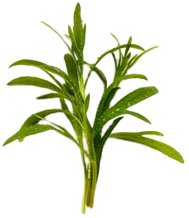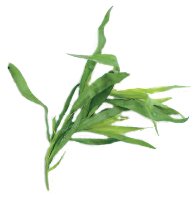

Tarragon

Artemisia. (Greek name for this plant.) WORMWOOD; SAGE BRUSH; MUGWORT. Compositae. Some 300 species of annual, biennial or perennial herbs or shrubs, usually aromatic. Leaves alternate, usually pinnately divided or finely dissected, often white-silky-hairy. Capitula inconspicuous, discoid, usually pendent, in a paniculate, racemose or corymbose inflorescence; involucre oblong to depressed-globose; phyllaries in a few series; receptacle naked, sometimes hairy; florets brown, red or yellow. Fruit a cypsela, obovoid, subterete or compressed, usually smooth; pappus absent or a small scarious ring. North temperate, Western S America, S Africa. CultivationAn important herbalist’s genus - Artemisia absinthium a source of absinthe and wormwood, Artemisia vulgaris, mugwort, a condiment with supposed magical properties. Although with a few notable exceptions (Artemisia lactiflora, Artemisia roxburghiana) the open flowers of Artemisia species exhibit a range of often grubby yellows, the genus offers an almost unrivalled diversity of attractively textured, aromatic foliage from the finest filigree of Artemisia armeniaca to the lobed or jagged-edged leaves in Artemisia stelleriana and Artemisia ludoviciana ‘Valerie Finnis’. Their colour ranges from aluminium white through glistening silvers to soft pewter greys, with morphology ranging from low mat-forming to hummock-forming types to tall and elegant species. Artemisia provides some of the mainstays of the silver border and a wealth of material for colour and textural contrast in the herbaceous, mixed and shrub border. Several of the border species, such as Artemisia pontica, with sage green filigree leaves, and the ash-white Artemisia ludoviciana, have a creeping rootstock but their invasive tendancies can be confined with slates. The taller species are inclined to flop onto other, less vigorous neighbours, especially on fertile soils, and should be provided with unobtrusive grow-through support in spring where this fallen habit is undesirable. Artemisia abrotanum will tolerate quite hard clipping and can be used for low hedging, especially in the herb garden; the dried leaves retain their fragrance well, for pot pourii, or for the traditional use as moth repellent, hence the French common name, ‘garde robe’. Artemisia dracunculus, tarragon, is grown for culinary use; eaten fresh in green salads or with poultry, cheese and eggs or steeped to impart its distinctive flavour to mild cider or wine vinegars for use in vinaigrette. The European or French tarragon is commonly held to be the best flavoured for culinary use; it is less vigorous than the Russian type and rarely sets seed; Russian tarragon has the advantage of being hardier; the flavour improves as the plant matures. The low-growing species include several robust types for the rock garden, including Artemisia stelleriana, the prostrate Artemisia stelleriana ‘Mori’, and the soft, finely divided Artemisia schmidtiana ‘Nana’, as well as more demanding high alpine mats and cushions that are more sensitive to winter set, such as Artemisia glacialis, Artemisia splendens and Artemesia genipi, for scree and crevice. Several species such as Artemesia eriantha, Artemisia umbelliformis, Artemesia pedemontana and Artemisia nitida are grown in troughs and raised beds, retaining a more desirable compactness on lean and gritty soils. Grow in full sun in any well-drained, moderately fertile circumneutral or slightly alkaline soil with greater emphasis on drainage for rock garden species; most of the genus show great tolerance of drought, especially Artemisia ludoviciana, Artemesia absinthium and its cultivars, together with Artemisia stelleriana and Artemisia schmidtiana. Artemisia lactiflora performs better on more moisture-rententive soils and will tolerate light shade. Artemisia genipi, glacialis, Artemisia umbelliformis and Artemisia splendens prefer neutral or acidic soils and, as with other low rock garden species, appreciate a collar or mulch of loose grit or gravel around the neck. Cut perennials back to ground level in autumn. Prune shrubs and woody based perennials such as Artemisia abrotanum and Artemisia arborescens by cutting hard back in spring, into older wood if necessary; Artemisia ‘Powis Castle’ should be pruned regularly and more lightly if necessary, since it does not appear to respond well to severe pruning. Propagate by division in spring or autumn, or shrubby species by softwood or heeled semi-ripe cuttings in summer.  Artemisia dracunculus
Artemisia dracunculus
TARRAGON; ESTRAGON. Aromatic, glabrous much-branched perennial, to 1-2m. Basal leaves 3-flowered at apex, stem leaves to 10 x 1cm, linear to lanceolate, entire or slightly toothed. Capitula recurved, globose, pedunculate, in a spreading panicle; involucre to 3mm; outer phyllaries oblong, more or less herbaceous, inner ovate, with a wide scarious margin; receptacle glabrous; florets yellow. SE USSR. Z3. There are many other members of the genus Artemisia but the information featured here is confined to culinary matters and considerations.
|
Home
Grow Nuts
Grow Fruit
Grow Vegetables
Cyberian Index
If you like this website and want one of your own contact
Cyberian All information correct at
time of publication and open to updates as necessary. No part of this website,
or its vectors, may be produced in any shape or form, using any type or design
of medium, system, equipment or otherwise without the prior written consensual
notice of the Cyberian. Any breach of these requirements will result in the
appropriate action. If in doubt, e-mail contact is recommended.
Some components of this website were obtained as open-source software and are
used in the same non-profit manner on this website.